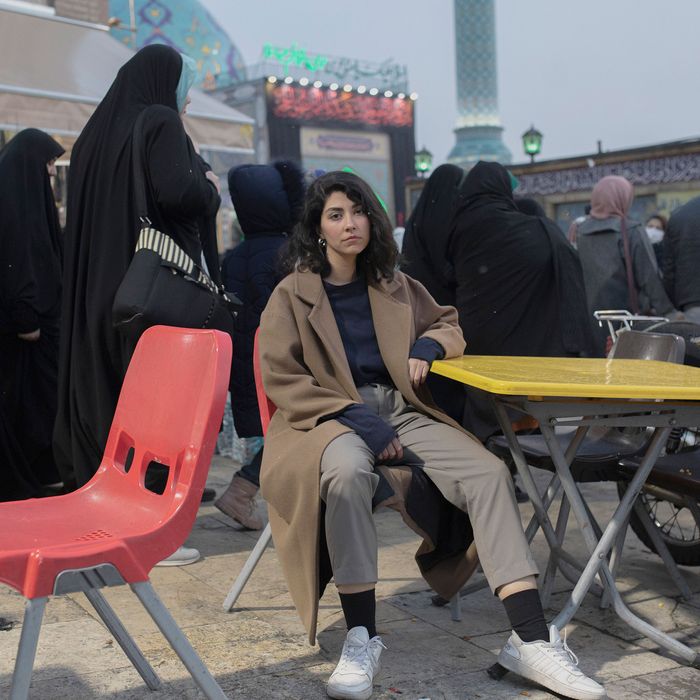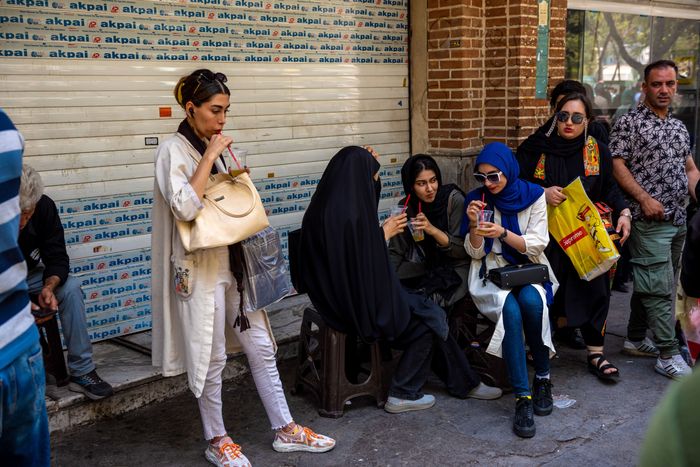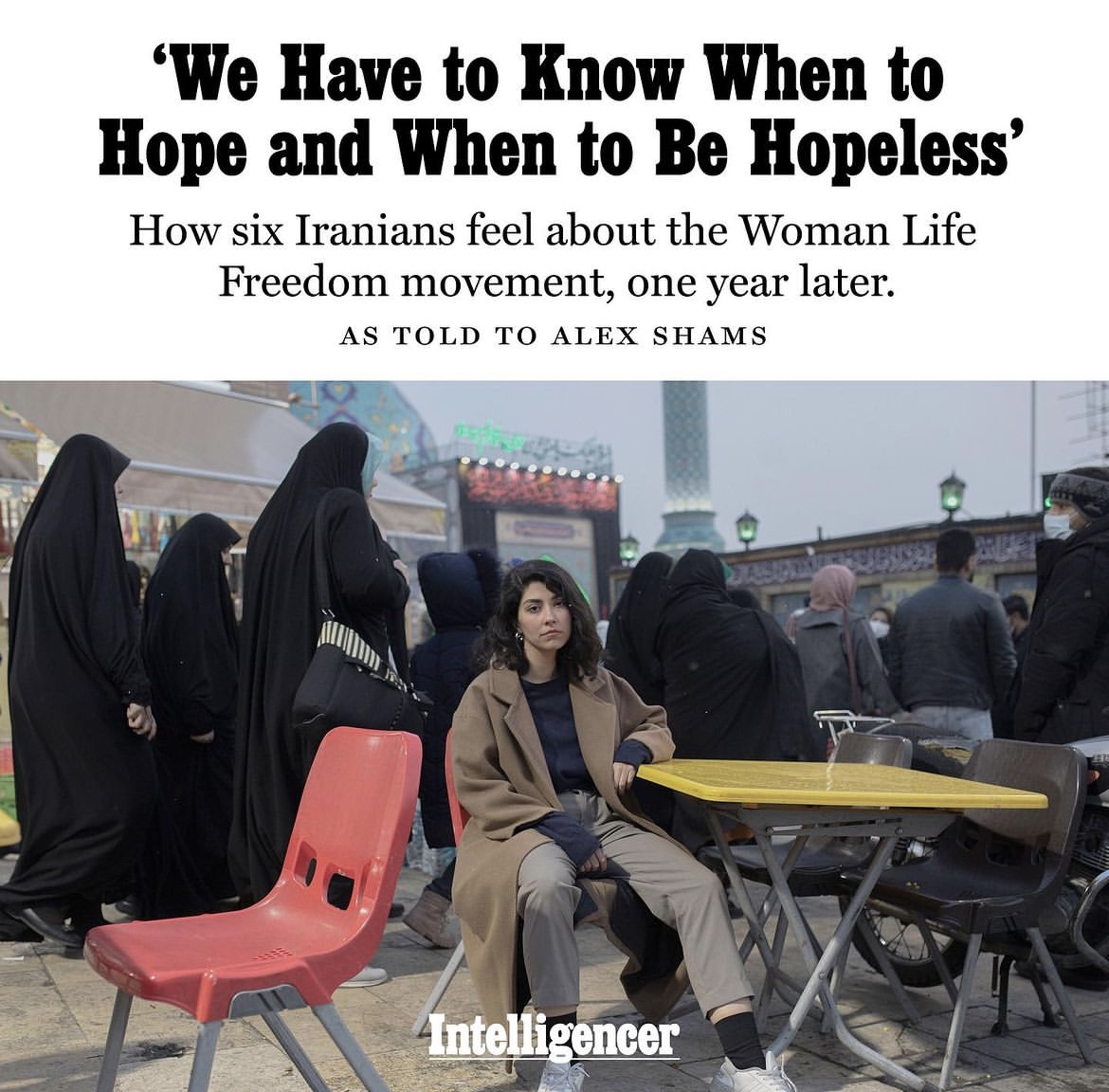First published in New York Magazine on Sept. 16, 2023.

One year has passed since protests first broke out across Iran following the killing of a young woman named Mahsa Zhina Amini on September 16, after she was detained by the morality police. Beginning in her hometown in Iranian Kurdistan and spreading to every corner of the country, thousands of Iranians marched demanding justice, supporting women’s rights, and calling for an end to the dictatorship under the current political system, under the banner of “Woman, Life, Freedom.” The government responded with severe repression, beating and arresting protestors, and shutting down the internet to prevent activists from organizing further.
Last fall, we spoke to six protestors about what kept them in the streets. Here, we reinterviewed the same people to understand how the movement has evolved. Iran’s government remains in power, the protests have largely quieted down, and many have tempered their hopes for the future. Last year, the morality police were disbanded; then this summer, the government announced they had resumed patrol, though the situation can vary depending on where you live. Those we spoke to in Iran weighed the wisdom of joining demonstrations to mark the one-year anniversary of the uprising. They reflected on the role of the Iranian diaspora on the movement, and what global allies might do differently. Whatever happens in the coming days, millions of Iranians — especially women and young people — continue to live their lives in open defiance of the government in ways previously unthinkable.
Female Teacher in Tehran, 30s
I almost never cover my hair when I go outside. For the first time, I’ve worn T-shirts and dresses in the street that I never could have imagined wearing before. I’ve enjoyed the feeling of a hot summer breeze on my body. I’ve also felt a lot of fear: of being arrested, of being shot, of being randomly pulled out of a crowd and beaten up. Sometimes the fear is really strong. But the urge that pushes you to keep walking in the face of the cops is real, too. I feel that all those people who were killed in the protests gave their lives so I could face this fear.
I’ve been depressed a lot over the past year. So many of my friends who are teachers are out of a job because they won’t go along with what the authorities demand. They’re fired or filtered out. But I’ve also felt the joy of being united with people I would never have seen myself connected to before. Even when we’re silent, there is a sense of solidarity among people. My sister wears hijab. She walks side by side with me when I’m not wearing hijab. She feels included in the movement and that she can support it by being by my side and giving me courage to live how I want. The movement has been successful in creating a collective aspiration for freedom if nothing else. I’ve realized that people like us shouldn’t try to leave Iran. We should stay and make it our home despite those who want us gone.
Male Civil-Society Activist in Sistan and Baluchistan Province, 33
I live in a city where protests haven’t stopped since the beginning of the movement, not even for a week. Even after the Bloody Friday massacrewhere the government killed many people. They typically happen after Friday prayers when people gather outside the mosque to march. And they will keep going. Still, the government acted with so much brutality that it is unlikely we will hold a protest quite like last year to mark the movement’s anniversary, since they’re likely to crackdown.
There is nothing that hasn’t changed in the last year. People, especially women and young people, have become so much braver than before. At the same time, my life and that of others have become much more difficult economically, especially because of the high inflation rate. The gap between state and society has deepened. As a result of the movement, the government is in a position of weakness. It is on the defensive, and it has become confused about its decision-making. So I am more hopeful than ever before about a brighter future.
Female Software Engineer in Tehran, 30
In many places, women go out with their hair uncovered. If a cop harasses or tries to detain a woman because of how she’s dressed, people nearby always intervene and fight back. That used to be rare, but now it’s very common. We have also adopted more diverse methods. I refuse to go anywhere that makes women wear hijab. I boycott places I’ve heard are owned by people who support the regime or places affiliated with the government. I’ve noticed that many children of people who work in the government’s lower ranks have turned against the state, and they tell me their parents have also changed their minds. There’s been a collapse in support for the government in the poorer sections of society.
Still, there are no more protests where I live. Almost everyone who was active in last year’s protests was either detained or beaten up at some point. If you’re at a gathering and mention that you were detained, everyone else says, “Oh yeah, me too.” Getting arrested didn’t have serious consequences for me, but I’m still waiting for the result of my case, so these days I’m more cautious. And besides being sent to prison, many people lost their jobs or had their phones and laptops taken and never returned.
Those of us who went into the streets last year accepted every risk that could happen to us: being killed or blinded or just disappearing. I don’t blame people for being afraid now. I doubt people will go into the streets again this year for the anniversary. But I think the movement did what it had to do. We went down a road that could have taken us ten years. As we move forward, it will become clear how much this movement shifted things. So many people experienced a revolution inside themselves. We have no choice but to not give up the hope that we might see a better day. On the other hand, when you’re hopeful, it can lead you to inaction. So we have to know when to hope and when to be hopeless. It’s important for us to be able to determine which one is appropriate when.

Male Student in Mashhad, 28
I don’t regret what I did last year or the risks I took that put my life in danger. But I’m not sure I would repeat them. Once I saw things start to become violent, I began to lose hope.
We’ve definitely witnessed many changes since then, but they haven’t unfolded the same way all over the country. In my city, in the religious and less privileged areas, it’s still looked down on for women to not wear hijab. But in richer areas of the city, most women don’t wear scarves outside anymore. Authorities no longer use brute force to police what women are wearing; the morality police are no more.
That doesn’t mean the government gave up. It just changed the way it implements restrictions. It moved from direct to indirect means to avoid conflict with the brave women in the streets. Today, it limits women’s freedom by pitting people against each other — for example, by shutting down businesses that serve uncovered women. To avoid being closed, some businesses put up signs asking women to wear hijab. The owners justify it by asking, “What’s more important, not wearing hijab or the jobs of all the people who will be unemployed if we’re shut down?” That’s how the government forces them to do what it wants. Despite this, many businesses resist government pressure.
The changes are not limited to hijab. Over the last year, society has radicalized into two camps. People in favor of and people against the regime are rapidly distancing themselves from each other. Those in the middle — who used to be the basis for dialogue — have been rejected by both sides. It seems there are only two options: either support the government or try to overthrow it at any cost. There is no room for independent views. Some call this shouting down of alternative views “the tyranny of hashtags.” The government does the same. These days, it’s trying to “purify” universities by firing professors who have shown even the slightest sympathy with protesting students.
Some parts of the opposition abroad have played a major role in deepening these faults. One of the biggest things many in the Iranian diaspora did was create false hope in the movement’s early days. They talked as if the government’s overthrow would happen quickly and easily. As the revolutionary fervor subsided and the government didn’t fall, this hope gave way to despair. I’ve become really discouraged by how some opponents of the regime act on social media — those who feel nostalgic for a time when Iran was a monarchy, who want it to return to that way of life, and who attack anyone they see as a threat to that. I feel very sad when I see fascist monarchist groups abroad trying to steal this movement from us. We have said our goal is opposing any type of dictatorship. Last year, we chanted: “Death to the tyrant, whether he is a king or a religious leader.”
If this movement was about hijab, then it was definitely successful. But the movement said it was going to bring down the regime. It wasn’t successful at that. It was so unsuccessful it didn’t even manage to unify the opposition. Everyone doesn’t have to agree, but at least they should form a united coalition opposing the regime. It couldn’t even manage that.
For months, authorities have been planning how to deal with possible protests on the anniversary of Mahsa Amini’s death. For example, at some colleges they started classes later than usual, or they went online for the first two weeks. They’ve reduced internet speed and access to VPNs. And they sent text messages to students threatening them not to participate. I haven’t decided whether I will protest. It’s not because I’m afraid of the regime’s repression. It’s because I’m afraid that reactionary, fascist groups abroad that want to bring dictatorship under a king to Iran will hijack our protests and use them to further their own goals.
Male Journalist and Political Activist in Saqqez, 36
Last year, I didn’t understand how things worked, and I imagined the movement would succeed quickly. After the protests ended, I was sad and hopeless for a long time. People around me are not willing to take to the streets anymore. I won’t either because I feel that protests won’t have any effect as long as people don’t have the right understanding of our struggle. There needs to be more education on what a movement like this takes. We must be patient and have a realistic view of the situation while rejecting false hope.
Iranians outside of Iran have a lot of power. They can intimidate our government and push for change in the international community’s behavior toward Iran. But forces on the extreme left and right have failed to understand our situation. Preoccupied by their nostalgic albums of photos from Iran’s past, they end up taking steps that align with what Iran’s government wants. They refuse to accept a future for this country that is anything other than what they want. Both the extreme Communist left wing and the extreme monarchist right wing acts like this.
Female Civil-Society Activist in Tehran, 45
Mentally, the last year has been very hard for me. Financially, I have struggled. Since last September, the government has been cutting off the internet regularly, whenever they think there might be a protest. I have experienced a sharp drop in my income because my job is online. On the other hand, since the movement began, daily life has become full of resistance. Today, I see people rejecting subservience to leaders and patriarchy in every part of their lives. In general, I’m more hopeful about the possibility of change. My desire to leave Iran has decreased.
It’s great that people abroad hold protests, but in the past year, we’ve learned that struggle is not just taking to the streets and chanting from windows. We no longer need to tell the world what is happening in Iran. Everyone knows. Instead, Iranians abroad should create funds to financially support the Iranian people’s struggle. [Note: Bank transfers from the U.S. to Iran are illegal due to sanctions on the country.] They should pay to help us get our cars back when authorities impound them due to hijab infractions. They should help us find ways around the regime’s internet censorship. Why should people inside Iran spend money on VPNs when Iranians outside can easily and cheaply help us pay for them? We need to organize ourselves so that we can live parallel lives apart from the state. This would help us become stronger and overthrow the government. But sometimes it just feels like they are waiting for us to take the lead while they watch.
